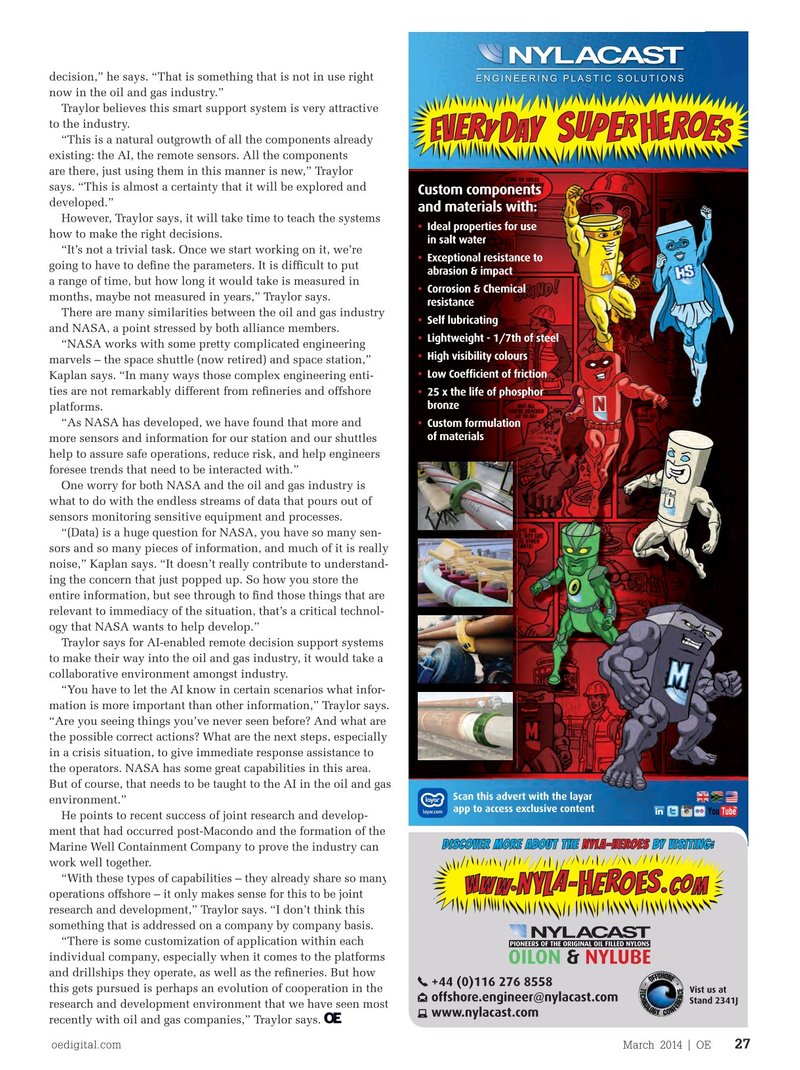
Page 25: of Offshore Engineer Magazine (Mar/Apr 2014)
Read this page in Pdf, Flash or Html5 edition of Mar/Apr 2014 Offshore Engineer Magazine
decision,” he says. “That is something that is not in use right now in the oil and gas industry.”
Traylor believes this smart support system is very attractive to the industry.
“This is a natural outgrowth of all the components already existing: the AI, the remote sensors. All the components are there, just using them in this manner is new,” Traylor says. “This is almost a certainty that it will be explored and
Custom components developed.” and materials with:
However, Traylor says, it will take time to teach the systems • Ideal properties for use how to make the right decisions.
in salt water “It’s not a trivial task. Once we start working on it, we’re • Exceptional resistance to going to have to defne the parameters. It is diffcult to put abrasion & impact a range of time, but how long it would take is measured in • Corrosion & Chemical months, maybe not measured in years,” Traylor says.
resistance
There are many similarities between the oil and gas industry • Self lubricating and NASA, a point stressed by both alliance members. • Lightweight - 1/7th of steel “NASA works with some pretty complicated engineering • High visibility colours marvels – the space shuttle (now retired) and space station,” • Low Coef? cient of friction
Kaplan says. “In many ways those complex engineering enti- ties are not remarkably different from refneries and offshore • 25 x the life of phosphor bronze platforms. “As NASA has developed, we have found that more and • Custom formulation of materials more sensors and information for our station and our shuttles help to assure safe operations, reduce risk, and help engineers foresee trends that need to be interacted with.”
One worry for both NASA and the oil and gas industry is what to do with the endless streams of data that pours out of sensors monitoring sensitive equipment and processes.
“(Data) is a huge question for NASA, you have so many sen- sors and so many pieces of information, and much of it is really noise,” Kaplan says. “It doesn’t really contribute to understand- ing the concern that just popped up. So how you store the entire information, but see through to fnd those things that are relevant to immediacy of the situation, that’s a critical technol- ogy that NASA wants to help develop.”
Traylor says for AI-enabled remote decision support systems to make their way into the oil and gas industry, it would take a collaborative environment amongst industry.
“You have to let the AI know in certain scenarios what infor- mation is more important than other information,” Traylor says. “Are you seeing things you’ve never seen before? And what are the possible correct actions? What are the next steps, especially in a crisis situation, to give immediate response assistance to the operators. NASA has some great capabilities in this area.
But of course, that needs to be taught to the AI in the oil and gas
Scan this advert with the layar environment.”
Insta app to access exclusive content
He points to recent success of joint research and develop- ment that had occurred post-Macondo and the formation of the
Discover more about the Nyla-Heroes by visiting:
Marine Well Containment Company to prove the industry can work well together.
“With these types of capabilities – they already share so many operations offshore – it only makes sense for this to be joint research and development,” Traylor says. “I don’t think this something that is addressed on a company by company basis. “There is some customization of application within each individual company, especially when it comes to the platforms and drillships they operate, as well as the refneries. But how +44 (0)116 276 8558 this gets pursued is perhaps an evolution of cooperation in the
Vist us at [email protected]
Stand 2341J research and development environment that we have seen most www.nylacast.com recently with oil and gas companies,” Traylor says. oedigital.com March 2014 | OE 27 000_OE0314_Digital2-NASA.indd 27 2/21/14 11:47 AM

 24
24

 26
26